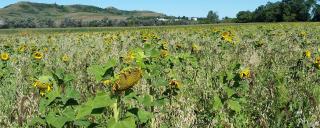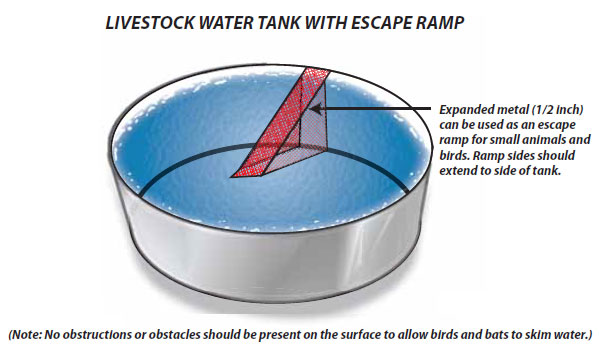
Wildlife Food Plots
The Game and Fish Department can pay an establishment cost-share and rental payment for wildlife food plot establishment. Access for walk-in hunting is required on most cost-share agreements. The PLOTS program for cost-share on food plot practices is the Wildlife Food Plots program.
Food for Wildlife
All wildlife need food. Sometimes humans feel the desire to help wildlife out, or to prevent animals from starving by providing an artificial food source. If done correctly, providing a food source for wildlife can be beneficial, but in most cases, feeding wildlife is detrimental.
Most supplemental feeding is focused on individuals or groups of animals, not an entire population. Humans perceive they are helping wildlife populations by supplying a food source, when in fact; they may only be affecting a small number of individuals. Supplemental feeding of wildlife is not a natural part of an animal’s life cycle. When wildlife are fed artificially, they can become dependent upon this artificial food source. Populations of wildlife can then become overpopulated and cause damage to property, spread diseases within the population and can become semidomesticated around people.
Humans feed wildlife for various reasons. Some feel that they are helping out the animals, while others feed wildlife to attract animals to their property. Some people plant wildlife food plots, such as corn, to provide a source of food through winter. Other people place food stations, such as feed bunks, grain screenings, corn and grain piles or other food, to attract animals to their property. Baiting, or placing food such as corn or grain in locations to attract wildlife for the purpose of hunting, has become an increasingly prevalent for hunting deer in North Dakota. This form of supplemental feeding can have many negative aspects, which can affect overall wildlife health.
An alternative method for attracting wildlife includes a combination of quality habitat and a wildlife food plot rather than bait or feed stations. Wildlife food plots provide a long-term food source while still keeping wildlife more naturally distributed to prevent diseases and other concerns. There are various types of food to plant for wildlife; the most common include annual food crops such as sunflower and corn. There are also other seed mixes available for perennial food plots. See the following recommendations for more information on annual and perennial food plots.
Annual Food Plots
Annual food plots can enhance wildlife survival and improve the wildlife habitat complex by providing readily available food. Food plots are especially important on land planned to provide a winter or early spring food source. In many areas with good quality winter habitat, the food source is unavailable or too far away. Food plots may reduce the impacts of weather and predators when placed in close proximity to winter protection. Food plots can also provide good nutrition for females preparing for their offspring.
- The recommended food plot size is 1/2 - 5 acres. One pheasant needs approximately one bushel of corn for a five-month period, while one deer needs approximately eight bushels. Design the food plot size according to the estimated population of wintering wildlife.
- Consider multiple food plots where adequate winter cover exists.
- Food should be located adjacent to or within one-quarter mile of winter cover. Plots should be located on the leeward side of protected areas. If not located on the leeward side of protected areas, snow drifting into food plots can be lessened by establishing snow traps.
- No-till planting is recommended to minimize erosion.
- Planting of the plot should be early enough in the year to ensure maturity of food plants.
- Adequately prepare the seedbed to ensure food plant establishment.
- Food plots will be undisturbed until seedbed preparation the following spring, except for cultivating or spraying to control weeds.
- Avoid planting food plots in a location that will increase wildlife activity near livestock feed supplies, newly planted trees or major roads and highways.
- Food plots established away from winter cover will increase wildlife mortality by exposing wildlife to weather elements and predators.
| Crop | Rate | Date |
|---|---|---|
| Corn | 12,000-18,000 plants/acre | May 20 |
| Sunflower (oil type) | 12,000-18,000 plants/acre row crop, 4-6 lbs./acre solid-seeded | June 5 |
| Millet (Proso) | 15-30 lbs./acre | June 25 |
| Sorghum (Grain) | 15-30 lbs./acre | May 25 |
| Barley | 60-90 lbs./acre | May 31 |
| Buckwheat | 50-60 lbs./acre | May 20 |
| Flax | 35 lbs./acre | June 10 |
| Oats | 50-80 lbs./acre | May 31 |
| Rye | 60-90 lbs./acre | Sep 30 |
| Wheat | 60-90 lbs./acre | May 31 |
| Sudangrass | 15-30 lbs./acre solid-seeded | May 20 |
| Lentil | 40-70 lbs. | May 20 |
| Winter Peas | 100-180 lbs./acre | May 20 |
| *Planting dates will vary with location, crop variety and weather conditions. | ||
Perennial Food Plots
Perennial food plots provide added dividends for birds, especially those species whose chicks depend on insects for food. Pheasant and sharp-tailed grouse chicks for example, rely heavily on insects. Perennial food plots composed of flowering forbs attract insects and provide food for chicks. These forbs also attract pollinating insects such as bees, which are beneficial in plant reproduction.
Perennial food plots can vary in size, and be located throughout the nesting habitat to provide adequate bugging sites for chicks.
Choose sites that are relatively free of noxious and invasive weed species (plants and seed bank) and that have soils suitable for planting a perennial food plot. Perennial food plots should be adjacent to or surrounded by suitable herbaceous nesting habitat.
Vigilance and timely control of weeds prior to and during the establishment period is required.
- Sites with weed problems should be maintained weed-free for at least two years prior to planting.
- A diverse mixture of native grasses and forbs is recommended. Do not exceed 25 percent grasses by seed count in the mixture. A suggested perennial food plot seed mix is listed on this page.
| Species | Variety | % | Rate PLS LB/AC |
|---|---|---|---|
| Grasses | |||
| sideoats grama | Pierre or Killdeer | 5 | 0.375 |
| blue grama | Bad River | 5 | 0.125 |
| switchgrass | Dacotah | 5 | 0.225 |
| Canada wildrye | Mandan | 5 | 0.375 |
| green needlegrass | Lodorm | 5 | 0.375 |
| Subtotal | 25 | ||
| Forbs (lb./acre rate shown is doubled from percent seed count shown) |
|||
| blanketflower | northern | 5 | 0.7 |
| black-eyed susan | northern | 5 | 0.08 |
| blue flax | Appar | 10 | 0.76 |
| yellow coneflower | Stillwater | 5 | 0.15 |
| purple prairieclover | Bismarck or northern | 15 | 1.14 |
| white prairieclover | Antelope or northern | 15 | 1.17 |
| Canada milkvetch | northern | 10 | 0.8 |
| Maximilian sunflower | Medicine Creek | 5 | 0.1 |
| stiff sunflower | Bismarck | 5 | 1.28 |
| Subtotal | 75 | ||
| Total | 100 | ||
Water for Wildlife
All wildlife need water. Some species such as waterfowl and shorebirds are water-dependent and spend all or part of their life cycle on or adjacent to wetlands, lakes or streams. Other species such as deer, pronghorn, elk, most bats and mourning doves require drinking water to survive. However, a large number of species do not require drinking water. Instead, they obtain water from foods (insects or vegetation) or from dew on vegetation. Sharp-tailed grouse, ring-necked pheasant, turkeys, song birds, greater prairie chicken and gray partridge do not need free drinking water to survive. Available free water will be used by these species, but is not critical to their survival.
In most cases, water is not a limiting factor for wildlife in North Dakota. North Dakota’s network of lakes, streams and wetlands provide water for most species. Very few areas north and east of the Missouri River will require supplemental water. In some instances west and south of the Missouri River, wildlife may benefit from additional water.
Adequate drinking water needs to be available during critical periods – spring through fall. Drinking water can be made available through development of small dams, dugouts, wells with tanks or troughs, and guzzlers.
Excavated or embankment ponds may be developed by creating small earth excavations that catch runoff or intercept ground water. Small dugout excavations up to 600 cubic yards approximately 8 feet deep can provide wildlife water. Small dams can also be constructed. In either case, an adequate water supply from runoff or ground water is needed. These types of structures are friendly to wildlife species including birds and bats. Bats drink by skimming the water surface. The larger the water surface, the easier it is for bats to obtain water.
Existing livestock tanks work well for wildlife water if the rim is low enough for wildlife to reach into the tank. Tanks and troughs require ramps to allow access for target species and escape for nontarget species where danger of drowning exists. If bats are using the tank or trough, it is important to remove all obstacles on the surface in order for the bats to skim the water.

An escape ramp should extend into the water and meet the inside wall of the trough. (See Figure 3.) Animals swimming along the perimeter will find the structure rather than become trapped behind or beneath the structure. The ramp should reach to the bottom of the tank and be firmly secured to the trough. The ramp should be made of grippable material with a slope not steeper than 45 degrees.

Guzzlers are wildlife watering facilities composed of a storage tank filled by rainwater collected by an impervious apron. Storage tanks are usually fully or partially buried below ground. Water collection aprons are often used to supply adequate water quantities. The work consists of excavating, shaping and placing earth materials for placement of aprons, tanks and other required components.
